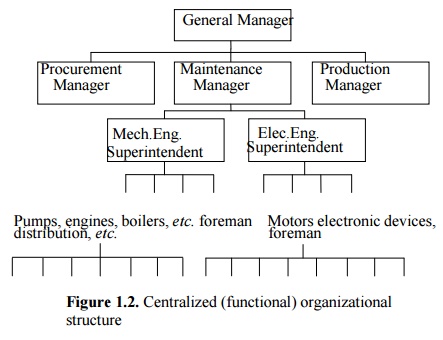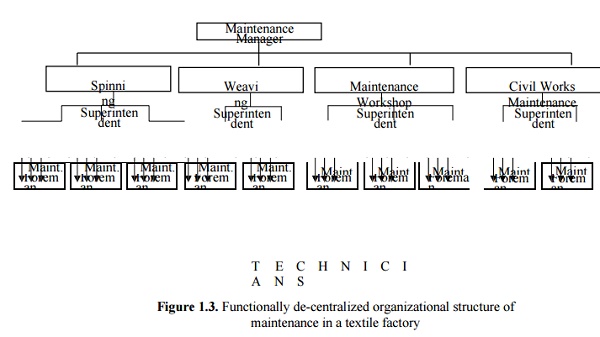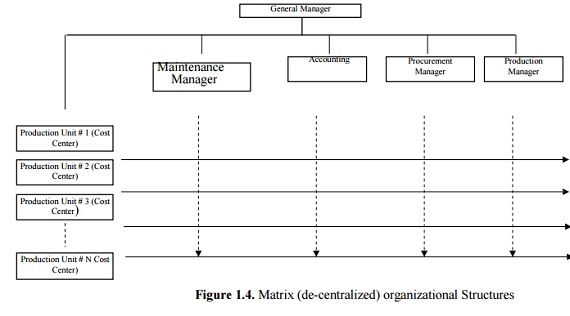Chapter: Mechanical : Maintenance Engineering : Principles and Practices of Maintenance Planning
Importance and benefits of sound Maintenance systems
Objectives and Principles of Planned
Maintenance Activity
Analysis
of repetitive equipment failures.
Estimation
of maintenance costs and evaluation of alternatives.
Assessing
required skills required for maintenance personnel.
Reviewing personnel transfers to and from
maintenance organizations assessing and reporting safety hazards associated
with maintenance of equipment.
Assessing
required maintenance tools
and skills required
for efficient maintenance
of equipment.
Assessing
required skills required for maintenance personnel.
Reviewing personnel transfers to and from
maintenance organizations assessing and reporting safety hazards associated
with maintenance of equipment.
Importance and benefits of sound
Maintenance systems
Minimization of down time
Life of equipment
Safety and smooth operation
Backup Supply
Reliability
Working environment
profit
1. Maintenance organization
·
Organizing is the process of arranging resources
(people, materials, technologyetc.) together to achieve the organization’s
strategies and goals.
·
The way in which the various parts of an
organization are formally arranged is referred to as the organization structure.
·
It is a system involving the interaction of inputs
and outputs.
·
However, there is no universally accepted
methodology for designingmaintenance systems, i.e., no fully structured
approach leading to an optimalmaintenance system (i.e., organizational
structure with a defined hierarchy ofauthority and span of control; defined
maintenance procedures and policies, etc.).Identical product
organizations, but different in technology advancement andproduction size, may
apply different maintenance systems and the differentsystems may run
successfully.
·
So, maintenance systems are designed
usingexperience and judgment supported by a number of formal decision tools
andtechniques.
·
Maintenance managers must have the capabilities to
create a division of laborfor maintenance tasks to be performed and then
coordinate results to achieve acommon purpose.
·
Solving performance problems and capitalizing on
opportunitiescould be attained through selection of the right persons, with the
appropriatecapabilities, supported by continuous training and good incentive
schemes, in orderto achieve organization success in terms of performance
effectiveness andefficiency..
2.Maintenance
Organization Objectives and Responsibility
A maintenance organization and its position in the
plant/whole organization is heavily impacted by the following elements or
factors:
•
Type of business, e.g., whether it is high
tech, labor intensive, production or service;
•
Objectives: may include profit maximization,
increasing market share and other social objectives;
•
Size and structure of the organization;
•
Culture of the organization; and
•
Range of responsibility assigned to maintenance.
Organizations
seek one or several of the following objectives: profit maximization, specific
quality level of service or products, minimizing costs, safe and clean
environment, or human resource development. It is clear that all of these
objectives are heavily impacted by maintenance and therefore the objectives of
maintenance must be aligned with the objectives of the organization.
The principal responsibility of
maintenance is to provide a service to enable an organization to achieve its
objectives. The specific responsibilities vary from one organization to
another; however they generally include the following according to Duffuaa et
al. (1998):
1.
Keeping assets and equipment in good condition,
well configured and safe to perform their intended functions;
2.
Perform
all maintenance activities
including preventive, predictive;
corrective, overhauls, design modification and
emergency maintenance in an efficient and effective manner;
3.
Conserve and control the use of spare parts and
material;
4.
Commission new plants and plant expansions; and
5.
Operate utilities and conserve energy.
The above responsibilities and
objectives impact the organization structure for maintenance as will be shown
in the coming sections.
3.Determinants
of a Maintenance Organization
The maintenance organization’s structure
is determined after planning the maintenance capacity. The maintenance capacity
is heavily influenced by the level of centralization or decentralization
adopted. In this section the main issues that must be addressed when forming
the maintenance organization’s structure are presented.
The issues are: capacity planning, centralization vs decentralization
and in-house vs outsourcing.
4.Maintenance
Capacity Planning
Maintenance capacity planning determines the
required resources for maintenance including the required crafts,
administration, equipment, tools and space to execute the maintenance load
efficiently and meet the objectives of the maintenance department. Critical
aspects of maintenance capacity are the numbers and skills of craftsmen
required to execute the maintenance load. It is difficult to determine the
exact number of various types of craftsmen, since the maintenance load is
uncertain. Therefore accurate forecasts for the future maintenance work demand
are essential for determining the maintenance capacity. In order to have better
utilization of manpower, organizations tend to reduce the number of available
craftsmen below their expected need. This is likely to result in a backlog of
uncompleted maintenance work. Maintenance Organization 7
5.
Centralization vs Decentralization
The decision to organize maintenance in a centralized,
decentralized or a hybrid form depends to a greater extent on the organization
is philosophy, maintenance load, size of the plant and skills of craftsmen. The
advantages of centralization are:
1. Provides more
flexibility and improves
utilization of resources such highly skilled crafts and special
equipment and therefore results in more efficiency;
2. Allows more
efficient line supervision;
3. Allows more
effective on the job training; and
4. Permits the
purchasing of modern equipment.
disadvantages:
1. Less utilization
of crafts since more time is required for getting to and from jobs;
2. Supervision of
crafts becomes more difficult and as such less maintenance control is achieved;
3. Less specialization on
complex hardware is
achieved since different persons work on the same hardware;
and
4. More costs of
transportation are incurred due to remoteness of some of the maintenance work.
In a decentralized maintenance
organization, departments are assigned to specific areas or units. This tends
to reduce the flexibility of the maintenance system as a whole. The range of
skills available becomes reduced and manpower utilization is usually less
efficient than in a centralized maintenance. In some cases a compromise
solution that combines centralization and decentralization is better. This type
of hybrid is called a cascade system. The cascade system organizes maintenance
in areas and whatever exceeds the capacity of each area is challenged to a
centralized unit. In this fashion the advantages of both systems may be reaped.
For more on the advantages and disadvantages of centralization and de-
centralization see Duffuaa et al. (1998) and Niebel (1994).
6
In-house vs Outsourcing
At this level management considers the sources for
building the maintenance capacity. The main sources or options available are
in-house by direct hiring, outsourcing, or a combination of in-house and
outsourcing. The criteria for selecting sources for building and maintaining
maintenance capacity include strategic considerations, technological and
economic factors. The following are criteria that can be employed to select
among sources for maintenance capacity:
1.
Availability and dependability of the source on a
long term basis;
2.
Capability of the source to achieve the objectives
set for maintenance by the organization and its ability to carry out the
maintenance tasks;
3.
Short term and long term costs;
4.
Organizational secrecy in some cases may be
subjected to leakage;
5.
Long term impact on maintenance personnel
expertise; and
6.
Special agreement by manufacturer or regulatory
bodies that set certain specifications for maintenance and environmental
emissions.
Examples
of maintenance tasks which could be outsourced are:
1.
Work for which the skill of specialists is
required on a routine basis and which is readily available in the market on a
competitive basis, e.g.,:
• Installation and
periodic inspection and
repair of automatic
fire sprinkler systems;
•
Inspection and repair of air conditioning systems;
•
Inspection and repair of heating systems; and
•
Inspection and repair of main frame computers etc.
2.
When it is cheaper than recruiting your own staff
and accessible at a short notice of time.
The issues and criteria presented
in the above section may help organizations in designing or re-designing their
maintenance organization.
7.Design
of the Maintenance Organization
A maintenance organization is subjected to
frequent changes due to uncertainty and desire for excellence in maintenance.
Maintenance and plant managers are always swinging from supporters of
centralized maintenance to decentralized ones, and back again. The result of
this frequent change is the creation of responsibility channels and direction
of the new organization’s accomplishments vs the
accomplishments of the former structure. So, the craftsmen have to adjust to
the new roles. To establish a maintenance organization an objective method that
caters for factors that influence the effectiveness of the organization is
needed. Competencies and continuous improvement should be the driving
considerations behind an organization’s design
and re-design.
8
Current Criteria for Organizational Change
Many organizations were re-designed to fix a perceived
problem. This approach in many cases may raise more issues than solve the
specific problem (Bradley, 2002). Among the reasons to change a specific
maintenance organization’s design are:
1. Dissatisfaction with
maintenance performance by
the organization or plant management;
2. A desire for
increased accountability;
4 . A desire to minimize manufacturing costs, so
maintenance resources are moved to report to a production supervisor, thereby
eliminating the (perceived) need for the maintenance supervisor;
4.
Many plant managers are frustrated that
maintenance seems slow paced, that is, every job requires excessive time to get
done. Maintenance people fail to understand the business of manufacturing, and
don’t seem to
be part of the team. This failure results in decentralization or distribution
of maintenance resources between production units; and
5.
Maintenance costs seem to rise remarkably, so more
and more contractors are brought in for larger jobs that used to get done
in-house.
9 Criteria
to Assess Organizational Effectiveness
Rather than designing the organization to solve a
specific problem, it is more important to establish a set of criteria to
identify an effective organization. The following could be considered as the
most important criteria:
1.
Roles and responsibilities are clearly defined and
assigned;
2.
The organization puts maintenance in the right
place in the organization;
3.
Flow of information is both from top-down and
bottom-up;
4.
Span of control is effective and supported with
well trained personal;
5.
Maintenance work is effectively controlled;
6.
Continuous improvement is built in the structure;
7.
Maintenance costs are minimized; and
8.
Motivation and organization culture.
10.
Basic Types of Organizational Models
To provide consistently the capabilities listed
above we have to consider three types of organizational designs.
•
Entralized maintenance. All crafts and related
maintenance functions report to a central maintenance manager as depicted in
Figure 1.2. The strengths of this structure are: allows economies of scale;
enables in-depth skill development; and enables departments (i.e., a
maintenance department) to accomplish their functional goals (not the overall
organizational goals). This structure is best suited for small to medium- size
organizations. The weaknesses of this structure are: it has slow response time
to environmental changes; may cause delays in decision making and hence longer
response time; leads to poor horizontal coordination among departments and
involves a restricted view of organizational goals.
•
Decentralized maintenance. All crafts and
maintenance craft support staff report to operations or area maintenance as
described in Figure 1.3. The strengths of this structure are that it allows the organization to achieve adaptability and
coordination in production units and efficiency in a centralized overhaul group and it facilitates
effective coordination both within and between
maintenance and other departments. The weaknesses of this structure are
that it has potential
•
• for excessive administrative overheads and may
lead to conflict between departments.
•
Matrix
structure, a form of a hybrid
structure. Crafts are allocated in some proportion to production units or area
maintenance and to a central maintenance function that supports the whole plant
or organization. The strengths of this matrix structure are: it allows the
organization to achieve coordination necessary to meet dual demands from the
environment and flexible sharing of human resources. The weaknesses of this
structure are: it causes maintenance employees to experience dual authority
which can be frustrating and confusing; it is time consuming and requires
frequent meetings and conflict resolution sessions. To remedy the weaknesses of
this structure a management with good interpersonal skills and extensive
training is required.

11.Material and Spare Parts Management
The
responsibility of this unit is to ensure the availability of material and spare
parts in the right quality and quantity at the right time at the minimum cost.
In large or medium size organizations this unit may be independent of the
maintenance organization; however in many circumstances it is part of
maintenance. It is a service that supports the maintenance programs. Its
effectiveness depends to a large extent on the standards maintained within the
stores system. The duties of a material and spare parts unit include:


1.
Develop in coordination with maintenance effective
stocking polices to minimize ordering, holding and shortages costs;
3.
Keep good inward, receiving, and safe keeping of
all supplies;
4.
Issue materials and supplies;
5.
Maintain and update records; and
6.
Keep the stores orderly and clean.
12.
Establishment of Authority and Reporting
Overall administrative control usually rests with
the maintenance department, with its head reporting to top management. This
responsibility may be delegated within the maintenance establishment. The
relationships and responsibility of each maintenance division/section must be
clearly specified together with the reporting channels. Each job title must
have a job description prescribing the qualifications and the experience needed
for the job, in addition to the reporting channels for the job.
13.
Quality of Leadership and Supervision
The organization, procedures, and practices
instituted to regulate the maintenance activities and demands in an industrial
undertaking are not in themselves a guarantee of satisfactory results. The
senior executive and his staff must influence the whole functional activity.
Maintenance performance can never rise above the quality of its leadership and
supervision. From good leadership stems the team- work which is the essence of
success in any enterprise. Talent and ability must be recognized and fostered;
good work must be noticed and commended; and carelessness must be exposed and
addressed.
14.
Incentives
The varied nature of the maintenance tasks, and
differing needs and conditions arising, together with the influence of
production activity, are not attuned to the adoption of incentive systems of
payment. There are, however, some directions in which incentives applications
can be usefully considered. One obvious case is that of repetitive work. The forward
planning of maintenance work can sometimes lead to an incentive payment
arrangement, based on the completion of known tasks in a given period, but care
must be taken to ensure that the required standards of work are not
compromised. In some case, maintenance incentives can be included in output
bonus schemes, by arranging that continuity of production, and attainment of
targets, provides rewards to both production and maintenance personnel.
15.
Education and Training
Nowadays it is also recognized that the employers
should not only select and place personnel, but should promote schemes and
provide facilities for their further education and training, so as to increase
individual proficiency, and provide recruits for the supervisory and senior
grades. For senior staff, refresher courses comprise lectures on specific
aspects of their work; they also encourage the interchange of ideas and
discussion.
The further education of technical grades, craft
workers, and apprentices is usually achieved through joint schemes, sponsored
by employers in conjunction with the local education authority. Employees
should be encouraged to take advantage of these schemes, to improve proficiency
and promotion prospects.
A normal trade background is
often inadequate to cope with the continuing developments in technology. The
increasing complexity and importance of maintenance engineering warrants a
marked increase in training of machine
operators and maintenance craftsmen through formal
school courses, reinforced by informed instruction by experienced supervisors.
The organization must have a well
defined training program for each employee. The following provides guidelines
for developing and assessing the effectiveness of the training program:
•
Evaluate current personnel performance;
•
Assess training need analysis;
•
Design the training program;
•
Implement the program; and
•
Evaluate the program effectiveness.
The evaluation is done either
through a certification program or by assessing the ability to achieve desired
performance by persons who have taken a particular training program.
The implementation of the above
five steps provides the organization with a framework to motivate personnel and
improve performance.
16.
Management and Labor Relations
The success of an undertaking depends
significantly on the care taken to form a community of well-informed, keen, and
lively people working harmoniously together. Participation creates satisfaction
and the necessary team spirit. In modern industry, quality of work life (QWL)
programs have been applied with considerable success, in the form of management
conferences, work councils, quality circles, and joint conferences identified
with the activities. The joint activities help the organization more fully
achieve its purposes.
17.
Summary
This chapter considered organizing
as one of the four functions of management. It is
the process of arranging resources (people, materials, technology, etc.)
together to achieve the organization’s
strategies and goals. Maintenance organization structure is the way various
part of the maintenance organization is formed including defining
responsibilities and roles of units and individuals. A set of criteria are
provided to assess and design organization structures and the main issues to be
addressed are outlined. The issues include centralization, decentralization and
outsourcing. The chapter describes three types of organization structures. In
addition, several functions that could support maintenance organization such as
material and spare management, training and the management of labor relations are
presented.
Related Topics